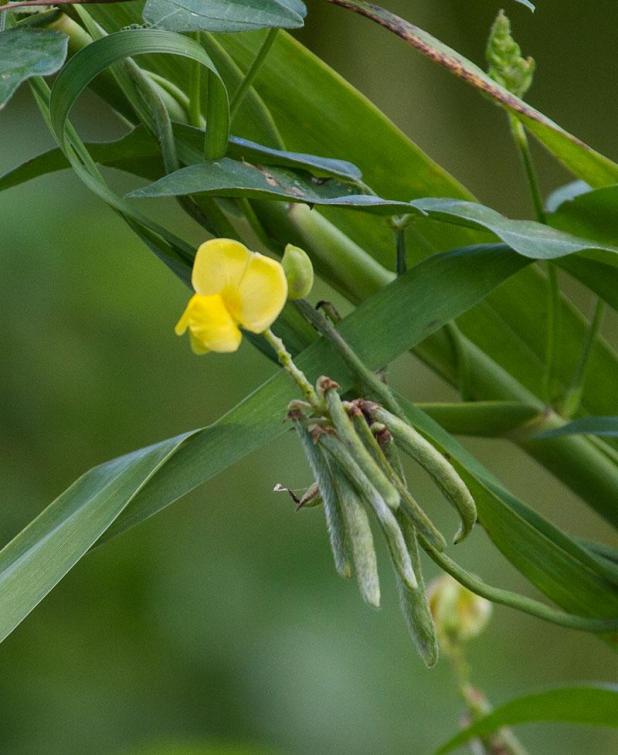
There is plenty of food resources in the marsh. Above, is marsh cowpeas. (Submitted Photo/John K. Flores)
The 2019-2020 deer season has opened
But who really feels like going when temperatures have been in the high 80s and low 90s much of September? In fact, September was the third hottest on record. I can’t remember the last time I went through the ninth month of the year without at least one cold front to take some of the bite out of the heat.
What’s more, it’s not until Tuesday when we’ll get our first rush of cool fresh air when temperatures are expected to drop a whopping 10 degrees. Well, it’s something, I guess, and at least it’s headed in the right direction.
Much of St. Mary Parish falls into Deer Hunting Areas 7 and 9. Area 7 is essentially the coastal marshes below U.S. 90, and Area 9 encompasses a portion of the Atchafalaya Basin swamp.
According to the 2018-2019 Louisiana Deer Report, the outlook for the 2019-2020 deer season is mixed due to what was considered desirable growing conditions across portions of the state and historic flooding across other parts. The report says timely rainfall and adequate habitat provided the new plant growth needed to meet the high protein and energy requirements to raise fawns. Unfortunately, St. Mary Parish fell into the historic flooding part of the state.
“The story for the 2019-2020 season will be the record setting floods in Louisiana,” Louisiana Department of Wildlife and Fisheries Deer Program Manager Johnathan Bordelon said. “The quick take away is that summer flooding was most detrimental within flood-impacted areas of the Mississippi River. Summer flooding correlated with lower lactation rates, which is used to index productivity in deer. Surprisingly, winter and spring floods did not correlate with decreased deer condition in the form of antler development and body growth.
“The lactation findings basically substantiated what we have observed in the past, both within the Atchafalaya Basin and the Mississippi River batture,” Bordelon continued.
“We are anticipating reduced fawn numbers for the Mississippi River batture and Atchafalaya Basin. This will carry forward into the future since a cohort will be reduced.”
The state’s report pointed out declines in lactation rates from studies conducted on lands enrolled in the Deer Management Assistance Program. Rates for 2-1/2 year old does were below 50 percent in 5 of the state’s 8 physiographic regions. Moreover, rates varied from 42 percent in the coastal marshes to 65 percent in the historic long leaf pine areas during the 2018-2019 season.
Essentially, this current year’s deer harvest in St. Mary Parish may or may not be impacted from flooding, but it will be in subsequent years when those reduced fawn numbers will impact herd populations.
Over the years in Terrebonne and St. Mary Parishes, tidal surge from hurricanes Lilli, Ike, Rita, Gustav, and more recently, Barry, have pushed 6 to 8 feet over the marsh below the Gulf Intracoastal Waterway.
On July 13, when the Atchafalaya River in Morgan City was already at the 8-foot, 3-inch foot flood stage (Note: Flood stage in Morgan City is 6 feet), Hurricane Barry’s surge pushed the water level even higher temporarily to the 10-foot, 5-inch flood stage. The water level breached levees near Burn’s Point and inundated marshes from Houma to Franklin, prime Area 7 deer hunting territory.
Where do these deer go to escape the flooding? Essentially, to higher ground. Whitetail deer in the swamp and marshes are quite comfortable traversing high water seeking safety.
“While many deer take refuge from flood waters outside of impacted areas, available food resources and deer densities are less than optimum,” Bordelon said. “Increase herbivory on food resources outside of the flooded areas does have the potential to negatively affect deer condition.
“Density-related competition and stress can also increase parasite and disease transmission risks for deer,” Bordelon added. “The full extent of this historic flood won’t be understood until the event is over.”
Statewide, hunter harvest declined for the third year in a row. During the 2015-2016 deer season, hunters harvested an estimated 156,100 deer. During the 2016-17, 2017-18 and 2018-19 deer seasons, harvest numbers steadily declined to 138,300, 135,100, and 120,800, respectively, in subsequent years.
Other department concerns besides dropping lactation rates across the state are feral hogs and chronic wasting disease.
From the state’s mail survey, hog harvest was estimated to be 135,800, exceeding deer harvest. What’s more, cervid carcass (deer, elk, moose) restrictions that the Louisiana Department of Wildlife and Fisheries enacted in March of 2017 are still in place. Recently, Tennessee became the 26th state to detect chronic wasting disease. No cases have been recorded in Louisiana.
During a recent tour in the marsh post Hurricane Barry, there appears to be plenty of food sources. Marsh cow peas — a preferred food — seem to be in abundance. There is plenty of alligator weed (AKA, water vine), willow leaves, vervain, spider lily, southern fern shield and briars deer eat to sustain themselves throughout the year; not to mention acorns, wild pecan and other mast.
In spite of the adversely warm weather, where deer limit their movements, archery season opened in Areas 3, 7 and 8, on Sept. 21. The remainder of the state opened Tuesday. Primitive weapon opens Oct. 12, in Area 7, and the regular firearm season opens Oct. 19. Hunters should check regulations for all specific dates and schedule.
EDITOR’S NOTE: Flores is The Daily Review’s Outdoor Writer.
